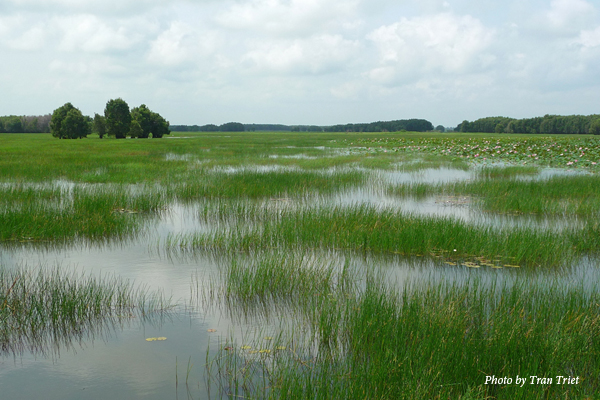
For more than 25 years, the International Crane Foundation has been deeply involved in the establishment and management of what is now Tram Chim National Park, the largest wetland national park in the Mekong River Basin of Southeast Asia. Earlier this year, Tram Chim was designated a Wetland of International Importance through the Ramsar Convention, an international treaty for the conservation and wise use of wetlands. It is an honor that Tram Chim is the 2,000th site to be recognized through the convention, which protects wetland sites – many important to cranes – throughout the world.
The International Crane Foundation first learned about Tram Chim in 1987 during an international meeting sponsored by the Foundation in China. There, our Co-founder Dr. George Archibald met Dr. Le Dien Duc, who reported on the rediscovery of Eastern Sarus Cranes at Tram Chim in 1986. Before this news, the Eastern Sarus Crane was considered one of the many casualties of the Vietnam War. George visited Tram Chim in 1988 and decided that the efforts there could be bolstered by a new wetland ecologist recently hired by the International Crane Foundation, Jeb Barzen, who has continued directing our activities at Tram Chim and the Lower Mekong Basin.

In the intervening quarter century, many people have contributed to the protection of this area: Mr. Nguyen Xuan Truong, the leader of resistance forces that depended on Tram Chim for survival during the Vietnam War; Mr. Ngo Quoc Thang, a young resistance soldier in the war who fell in love with Tram Chim and was buried on it’s margins; Mr. Bjorn Larsen, Mr. Nguyen Huu Thien, International Crane Foundation’s President Dr. Rich Beilfuss and Director of Southeast Asia Programs Dr. Tran Triet, who advanced their careers through graduate work at Tram Chim; Ms. Huong Payson, an overseas Vietnamese who nurtured Tram Chim as “her baby”; Mr. Nguyen Van Hung, who has grown from an assistant biologist to the Park’s director over a 20-year tenure with the park; and other conservation organizations like World Wildlife Fund, IUCN and the Mekong River Commission, who have played important roles at Tram Chim as well. Ultimately, Tram Chim is a legacy for which Vietnam, the International Crane Foundation and it’s many collaborators, can be proud.
Learn more about the International Crane Foundation’s current research studying pollutants in the Mekong River Basin.
Other Ramsar sites important to cranes include Horicon National Wildlife Refuge in Wisconsin (release site for the Whooping Crane reintroduction), Zhalong and Poyang Lake Nature Reserves in China, the Zambezi Delta and Kafue Flats in Africa and many more! Look for our article in the May issue of our newsletter The Bugle to learn more about the impact of the convention on crane conservation.
